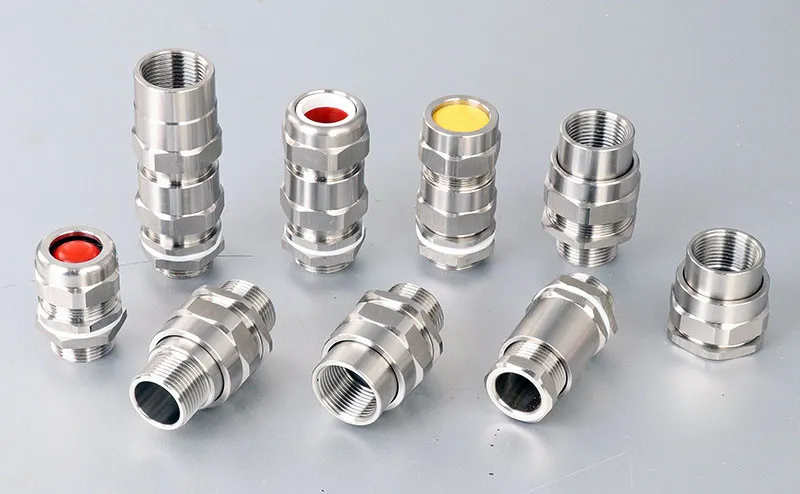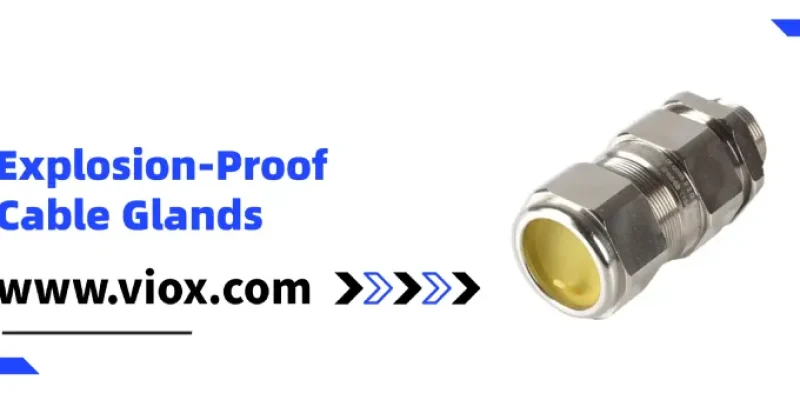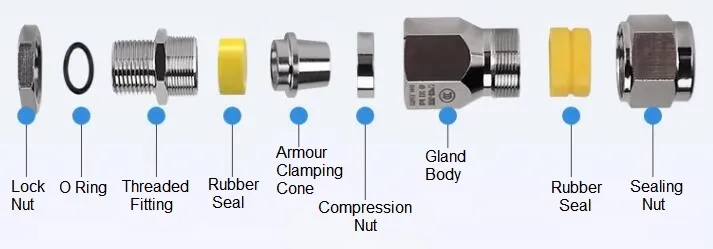Przeciwwybuchowe dławiki kablowe to kluczowe elementy bezpieczeństwa zaprojektowane w celu zapobiegania rozprzestrzenianiu się płomienia i minimalizowania ryzyka wybuchu w niebezpiecznych środowiskach. Ten kompleksowy przewodnik omawia kluczowe cechy, kryteria wyboru, wymagania instalacyjne i zastosowania tych niezbędnych urządzeń do utrzymania bezpieczeństwa elektrycznego w strefach zagrożonych wybuchem.
Podstawy dławnic przeciwwybuchowych

Przeciwwybuchowe dławiki kablowe to specjalistyczne urządzenia mechaniczne przeznaczone do bezpiecznego łączenia kabli ze sprzętem elektrycznym w środowiskach niebezpiecznych, w których mogą występować łatwopalne gazy, opary lub palne pyły. Gruczoły te pełnią dwie kluczowe funkcje:
- Zapewniają bezpieczne i pewne uszczelnienie wokół kabla, zapobiegając przedostawaniu się substancji wybuchowych do obudów elektrycznych..
- Powstrzymują one wszelkie potencjalne eksplozje, które mogą wystąpić wewnątrz sprzętu, zapobiegając ich rozprzestrzenianiu się do otaczającej atmosfery.
Wyjaśnienie mechanizmu działania
Przeciwwybuchowe dławnice kablowe działają na zasadzie podwójnego działania, zapobiegając rozprzestrzenianiu się płomieni i powstrzymując potencjalne eksplozje. Podstawowy mechanizm obejmuje solidny system uszczelniający, zwykle wykorzystujący elastomerowe lub gumowe uszczelki, który tworzy nieprzepuszczalną barierę przed wnikaniem gazu i pyłu. Uszczelnienie to zapobiega również wydostawaniu się wewnętrznych eksplozji z obudowy.
Drugim mechanizmem jest ognioodporna konstrukcja, która pozwala dławnicy wytrzymać i powstrzymać wewnętrzne eksplozje. Jeśli w urządzeniu dojdzie do eksplozji, konstrukcja dławnicy umożliwia chłodzenie i gaszenie gorących gazów, które próbują się wydostać, obniżając ich temperaturę poniżej punktu zapłonu otaczającej atmosfery. Ten proces hermetyzacji i chłodzenia skutecznie zapobiega rozprzestrzenianiu się wybuchu do środowiska zewnętrznego, zapewniając bezpieczeństwo w niebezpiecznych obszarach, w których występują substancje łatwopalne.
Przeciwwybuchowy dławik kablowy Struktura i konstrukcja
Przeciwwybuchowe dławiki kablowe składają się zazwyczaj z kilku kluczowych elementów zaprojektowanych w celu zapewnienia bezpieczeństwa w niebezpiecznych środowiskach:
- Korpus: Zwykle wykonane z wytrzymałych materiałów, takich jak mosiądz, stal nierdzewna lub aluminium, aby wytrzymać ekstremalne warunki.
- System uszczelniający: Zawiera uszczelki kompresyjne i bariery przeciwpożarowe, aby zapobiec przedostawaniu się gazu lub pyłu i powstrzymać potencjalne źródła zapłonu.
- Mechanizm zaciskowy: Zabezpiecza kabel i zapewnia odciążenie, często z zaciskiem pancerza do łączenia elektrycznego w kablach pancernych.
- Bariera złożona: Niektóre modele są wyposażone w trwałą epoksydową masę uszczelniającą w celu zwiększenia ochrony przeciwwybuchowej.
- Gwint: Gwinty metryczne lub NPT do bezpiecznego mocowania do obudów, często wyposażone w O-ringi zapewniające stopień ochrony IP66/68.
Konstrukcja różni się w zależności od typu kabla i wymagań strefy niebezpiecznej. Na przykład, dławnice CG.EM zawierają wewnętrzny pierścień ekranujący dla ochrony EMC w przypadku kabli ekranowanych, podczas gdy dławnice CG.AR posiadają dodatkowe uszczelnienie dla kabli opancerzonych.
Kluczowe cechy i materiały
Zaprojektowane, aby wytrzymać ekstremalne warunki, komponenty te wykorzystują wytrzymałe materiały dostosowane do określonych środowisk:
- Mosiądz i mosiądz niklowany: Idealne do standardowych zastosowań przemysłowych ze względu na trwałość i opłacalność.
- Stal nierdzewna: Oferuje doskonałą odporność w środowiskach korozyjnych lub morskich, zapewniając długą żywotność w trudnych warunkach.
- Opcje odporne na korozję: Specjalistyczne materiały, takie jak aluminium lub warianty niemetaliczne, zaspokajają potrzeby środowisk o wyjątkowym narażeniu chemicznym.
Taki wybór materiałów zapewnia kompatybilność z różnymi wymaganiami eksploatacyjnymi, przy zachowaniu bezpieczeństwa i zgodności z przepisami.
Przewodnik po rozmiarach dławików kablowych
Tabele rozmiarów dławików kablowych w wykonaniu przeciwwybuchowym są niezbędnymi narzędziami do wyboru odpowiedniego dławika dla określonych wymiarów kabla i zastosowań. Tabele te zazwyczaj korelują rozmiary kabli, liczbę żył i odpowiadające im rozmiary dławików. Na przykład kabel 25 mm² z czterema żyłami wymagałby dławika o rozmiarze 32. Wykresy obejmują szeroki zakres rozmiarów kabli, od 1,5 mm² do 1000 mm², oraz numery żył od 1 do 48.
Kluczowe kwestie podczas korzystania z tych wykresów obejmują:
- Średnica kabla: Mierzona nad zewnętrzną powłoką w przypadku kabli nieopancerzonych lub nad pancerzem w przypadku kabli opancerzonych.
- Liczba żył: Wpływa na całkowitą średnicę kabla i wymagany rozmiar dławika.
- Rozmiar gwintu: Zazwyczaj dostępne są gwinty metryczne (od M20 do M130) lub gwinty NPT.
- Typ pancerza: Różne konstrukcje dławików mogą być potrzebne dla różnych stylów pancerza.
Zawsze należy zapoznać się z tabelami i wytycznymi producenta, ponieważ rozmiary mogą się różnić w zależności od modelu i typu dławika. Należy pamiętać, że te wykresy mają charakter orientacyjny, a czynniki takie jak warunki środowiskowe i określone wymagania dotyczące stref niebezpiecznych mogą mieć wpływ na ostateczny wybór dławika.
Standardy certyfikacji i ochrony
Zgodność z międzynarodowymi normami bezpieczeństwa ma kluczowe znaczenie dla dławnic kablowych w wykonaniu przeciwwybuchowym. Komponenty te muszą spełniać rygorystyczne certyfikaty, w tym ATEX, IECEx, cCSAus i UL, aby zapewnić zgodność z globalnymi wymogami bezpieczeństwa. Stopnie ochrony, takie jak Ex d (ognioszczelność), Ex e (zwiększone bezpieczeństwo) i Ex nR (ograniczone oddychanie), mają zasadnicze znaczenie, ponieważ poziom ochrony dławika musi odpowiadać lub przewyższać poziom ochrony podłączonego sprzętu. Dodatkowo, stopnie ochrony IP są niezbędne do określenia odporności dławika na wnikanie wilgoci i pyłu, zapewniając odpowiednie uszczelnienie środowiskowe w różnych warunkach operacyjnych.
Wybór odpowiednich dławików
Wybierając odpowiednie przeciwwybuchowe dławiki kablowe, należy wziąć pod uwagę następujące kluczowe czynniki:
- Klasyfikacja obszaru niebezpiecznego: Określić konkretną strefę (0, 1 lub 2 dla gazu, 20, 21 lub 22 dla pyłu), w której zostanie zainstalowana dławnica.
- Typ ochrony: Wybierz dławnice, które odpowiadają wymaganej metodzie ochrony, takiej jak zwiększone bezpieczeństwo (Ex e) lub ognioszczelność (Ex d).
- Typ i rozmiar kabla: Zapewnienie zgodności z określoną średnicą i konstrukcją kabla, w tym z kablami opancerzonymi lub ekranowanymi.
- Warunki środowiskowe: Należy wziąć pod uwagę takie czynniki, jak skrajne temperatury, atmosfera korozyjna i wymagania dotyczące stopnia ochrony (IP).
- Wybór materiału: Wybierz materiały odporne na korozję, takie jak stal nierdzewna lub mosiądz, w zależności od środowiska.
- Certyfikaty: Sprawdź, czy dławik spełnia odpowiednie normy międzynarodowe (ATEX, IECEx, NEC) dla danego regionu i branży.
Dokładna ocena tych kryteriów pozwala wybrać dławik kablowy w wykonaniu przeciwwybuchowym, który zapewnia bezpieczeństwo, zgodność z przepisami i optymalną wydajność w niebezpiecznych środowiskach.
Podręcznik instalacji i użytkowania
Podczas korzystania z dławików kablowych w wykonaniu przeciwwybuchowym, prawidłowa instalacja i konserwacja mają kluczowe znaczenie dla zapewnienia bezpieczeństwa w niebezpiecznych środowiskach. Oto kluczowe kroki i uwagi:
- Wybierz odpowiedni typ dławika w oparciu o rozmiar kabla, pancerz i klasyfikację strefy niebezpiecznej.
- Upewnij się, że przewód został czysto przecięty i usunięto odpowiednią długość powłoki zewnętrznej.
- Przełóż kabel przez elementy dławika w odpowiedniej kolejności, zwracając uwagę na orientację części, takich jak stożek pancerza.
- Dokręć elementy dławika z określonym momentem, zgodnie z wytycznymi producenta.
- W przypadku dławików barierowych w środowiskach Ex d należy starannie przygotować kabel, usuwając wypełniacze i wewnętrzną powłokę zgodnie z wymaganiami.
- Regularnie sprawdzaj dławiki pod kątem oznak uszkodzenia lub zużycia, wymieniając je niezwłocznie w przypadku wykrycia problemów.
- Nigdy nie próbuj naprawiać uszkodzonego dławika; zawsze wymieniaj go na nową, certyfikowaną jednostkę.
Należy pamiętać, że przeciwwybuchowe dławiki kablowe nie nadają się do użytku z urządzeniami przenośnymi i powinny być używane wyłącznie w instalacjach stałych. Zawsze należy zapoznać się ze szczegółowymi instrukcjami producenta, ponieważ szczegóły instalacji mogą się różnić w zależności od typu i modelu dławnicy.
Zastosowania w niebezpiecznych branżach
Szeroko stosowane w środowiskach wysokiego ryzyka, przeciwwybuchowe dławiki kablowe odgrywają kluczową rolę w utrzymaniu bezpieczeństwa w różnych branżach. Te wyspecjalizowane komponenty znajdują szerokie zastosowanie w zakładach naftowych i gazowych, zakładach przetwórstwa chemicznego, kopalniach i obszarach przeładunku materiałów niebezpiecznych. Ich podstawową funkcją jest zapobieganie rozprzestrzenianiu się iskier, powstrzymywanie potencjalnych eksplozji i utrzymywanie integralności instalacji elektrycznych w potencjalnie lotnych atmosferach. Zapewniając solidne uszczelnienie środowiskowe i przestrzegając rygorystycznych norm bezpieczeństwa, dławnice te zapewniają bezpieczną pracę sprzętu elektrycznego w strefach, w których mogą występować łatwopalne gazy, opary lub palne pyły.



